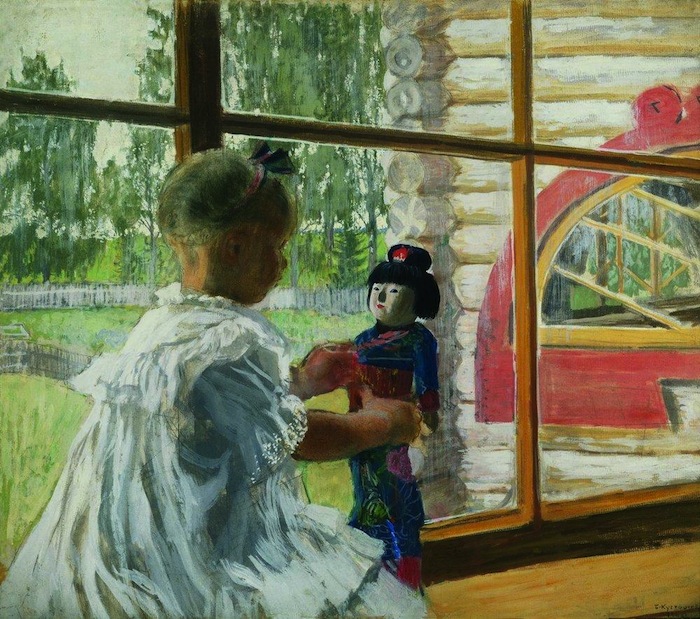This past summer I went to France after many years away, and I was able to immerse myself in the Impressionist masterpieces in the great museums of Paris. The first day we arrived I met a school group and took a tour of Giverny, Monet’s gardens not far from Paris. Our crowded tumble through the flowering beds and colorful gardens gave us a feast for the eyes, and we took hundreds of pictures of the glowing flowers. Only later, in Paris, did I fully understand that they had been carefully recreated from the documents of Monet’s paintings, faithfully continuing his vision of their wild riot of color.
Inside Monet’s house, the walls, the paintings, the colors of china and furniture continued this visual fantasy. It was luscious. For lunch we went to a restaurant a few steps down the road, called “La Ferme,” which has been in operation since the days when Monet and Jean Renoir would come for a glass of Sancerre. A warm, poetic light fell on blond, wood-paneled walls, and glinted from the glasses, a light that had inspired Renoir to paint his friends at the same table a century ago. In Paris, I stood in homage for hours inside the walled room of water lilies in The Orangerie, an oval room where one can experience in 360 degrees a world of color stretching out from a single point of view, in Monet’s incredible continuous circular painting of a pond that reflects the light and depth of the sky on its surface. It is an experience of such poetry I said to my son, “This room is why I brought you to Paris.”
The Impressionists were students of observation. On line, it is now possible to view over fifteen hundred paintings Monet and Renoir did over the course of their careers. Over 1500 each. When I looked at Monet’s paintings chronologically, I could see that he would go to the same place and paint the same scenes and subjects over and over again, at different times of day, altering the tone, mood and meaning of each painting. For Monet, painting was a daily practice.
For each of us, a treasure of hidden material is stored within our memories, waiting for a way to come to the surface. The writing exercises in The Path to Creativity are designed to awaken the specific memories, ideas, and experiences that give our lives meaning. Writing allows us to undertake a profound journey into the heart of our own imagination. Like a musician with a musical etude, or a painter arranging a still life of objects on a table to portray, we can pick up a pen and paper and try out some of the subjects in these pages. Jack Kerouac once wrote, “Something that you feel will find its own form.” When we write out of personal experience, we strengthen our ability to express the unique creative vision we are destined to share with the world. Creativity is part of us. Those who can take the time to develop and refine this innate gift will find they have begun a process that can awaken the artist within. When we take one step in this direction, we begin a journey filled with beauty and emotional power. There is no more important gift you can give your life, than exploring the path to your own creativity.

Lost and Found
Make a list of some of the things you ever loved and lost. Start anywhere, a little toy you remember, a favorite t-shirt, your childhood nightgown with the roses embroidered on the collar. Go through the rummage sale of your mind, and remember them, and fill a page with the things you bring to mind. Whenever you feel the urge, expand on the item and explain its importance, its physical shape, color, texture, condition when new, when lost. When the page is full, read it over carefully, and underline the sentences about your favorite remembered lost item, or circle it. One or two will have stories connected to them, so tell the one that calls your name.
On a fresh sheet of paper, or a new “document” in your PC, write about this object in particular, and about any ideas or memories that surface as you begin. There’s no pre-conceived form for this exercise, but you may discover this simple object may give you a story to tell. Take your time and enjoy the adventure. You will “find” something you lost.
This article is adapted from Charity Hume’s new book, The Path to Creativity: Creative Writing Exercises to Awaken the Artist Within, available at http://www.charityhume.com/store/.
Image: Top, Monet’s The Sheltered Path; below, Boris Kustodiev’s Japanese Doll. Images courtesy of Wikipaintings.
Charity Hume is a writer and teacher who lives and works in Los Angeles. A former director of The NYU Creative Writing Program, she is the author of The Path to Creativity: Creative Writing Exercises to Awaken the Artist Within and The Wisdom in the Room: A Teacher's Guide, available on her website, and at Amazon, Kindle, and Createspace.
